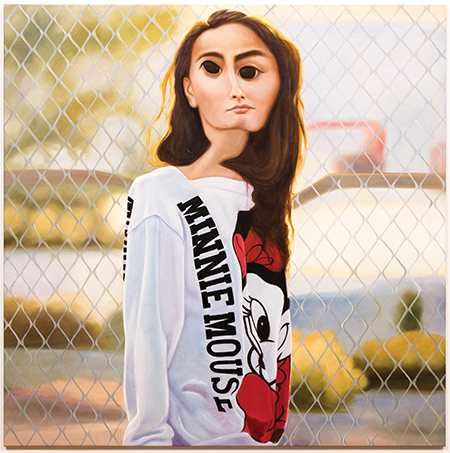Ryder Ripps

That feminism is measured in ‘waves’ seems apropos; waves crash, engulf, ebb away – just as feminism is marked by periods of concerted interest and disinterest. It feels as if we are at the brink of another wave of engagement, and yet it’s amazing what people get away with when feminism – or racism, or any other number of intersecting issues – isn’t at the forefront of our collective conscious.
The backstory to Ryder Ripps’s exhibition at Postmasters, ‘Ho’, is that the artist was fascinated with the selfie-laden Instagram account of model, entrepreneur and fitness advocate Adrianne Ho. (Ho is Canadian with French and Chinese ancestry, hence the show’s title is a play on her last name that manages to be racist and misogynist simultaneously.) Ripps takes Ho to be a representative of a vague cultural phenomenon the artist titles ‘corny-core’. In an online slideshow hosted on Tumblr that Ripps created for the show, he writes: ‘Corny-core things bring a mawkishly sentimental tone to everyday, common things [through] the gratuitous use of filters and vague sentiment under the guise of documentation.’ (The term clearly rides on the coat-tails of K-Hole’s neologism ‘norm core’, shortlisted for the Oxford English Dictionary’s word of the year in 2014.) He further explains his process: ‘I began screen capping Adrianne Ho’s photos and digitally warping them ... it just felt like the natural thing to do with bottled-up emotion […] At its core, the work is pretty aggressive.’ And he’s not wrong. Ripps has manipulated the images to make her look ugly by conventional standards, and then created oil paintings based on his digitally modified images. In one painting, her nose becomes bulbous to the point of disfiguration (Nose Reflection, all works 2014); in another, her face is compressed into an alien-like arrangement (Mona Lisa); an additional work shrinks her waist to a spine’s width (Hourglass). This, of course, is a pointed thing to do to an image of a woman whose power hinges on her body’s appearance and her control over it. According to Ripps, Ho’s images made him ‘feel flustered’: the desire to alter her body stemmed from his feelings of frustration and emasculation – that, because he was overwhelmed by the strength and confidence of a beautiful woman, he felt the need to exercise his power over her by dehumanizing her image. In his aforementioned online slide presentation, Ripps writes: ‘I felt some similarities with Francis Bacon, imposing a similar sense of carnage and aggression onto the subject […] Feeling good about where the work sat in the context of art history, particularly oil painting, I decided to hire Jeff Koons’s assistants to paint the pieces.’ Ripps also cites Thomas Hart Benton (a notorious homophobe) and the abstract expressionists, but none of these grab-bag references seem evident in the work itself.
It’s impossible to write about this show without mentioning the hullabaloo surrounding it. Ripps is internet hipster royalty, having created the image-sharing messageboard dump.fm and founded the advertising agency OKFocus. Just weeks before ‘Ho’ opened, Ripps had invited sex workers or ‘sensual masseurs’ to the Ace Hotel in Chelsea, where he then asked them to draw and paid them $80 for a 45-minute session. The Ace had offered to put Ripps up in the hotel for a night and given him a $50 fee as part of a rotating artist residency programme. Ripps posted images of these sex workers and an artist statement, claiming that their sexual exploitation was symbolic of his own, considering himself underpaid by the Ace. This project, titled ‘Art Whore’, lost Ripps much public support, but gained him incalculable attention from the press.
Some male artists, curators and writers seem to think that if they put something that is inadvertently misogynist into the world with purportedly good intentions, they shouldn’t be publicly censured in the name of free speech. If they feel that women demanding to be treated with respect tramples on their rights, maybe privilege has become so entrenched with identity that it has become blinding. ‘While the work is aggressive, it’s also emasculating,’ Ripps writes in his online slide show, ‘as Adrianne Ho is the real winner, with more followers than me.’ As if the artist’s actions were null because Ho has more Instagram followers, because that’s what really matters.
The most upsetting aspect of this situation is that a male artist was afforded the opportunity to mount such a misogynistic exhibition at a highly respected Manhattan gallery. And why? Because of his internet fame? Because Postmasters considers Ripps an innovative contemporary figurative painter? Why give gallery space to those big online, if they’re otherwise not talented? If we’re going to prevent contemporary art from becoming a full-tilt attention game, we need to stop showing artists like Ripps.
















